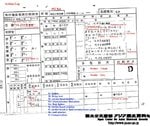Thank-you very much, Shinpachi san.
Your 3D CG model confirms it is A6M. I had viewed a number of A6M wreck photos at other locations which showed the engine mount to be typical of this aircraft. Thanks for assuring us it is most likely A6M2 or A6M2-N model.
Aichi E13A 3-seat Suitei, Jake floatplanes, of 452nd Ku also operated in the Aleutians but SuiTei are much larger aircraft and would not have had holes in upper part of firewall for 7.7mm MG. The firewall can be seen in the photo below.

Credit: BuAer via eBay Auctions
I enjoyed very much the 2 flight logs of 752nd Ku G4M Rikko missions to
Attu.
The 2nd log which describes the mission on 24th May 1943 where they encountered 10 USAAF P-38 Lightning fighters is told by a pilot on the US side here:
Attu Campaign - Aleutians scroll down to description of P-38 fighters attacking G4M Betty during raid on Attu
One other mystery is why the SuiSen float fighters were sent to Attu. I think not to escape the American bombing at Kiska, but perhaps the weather at Kiska harbour was much more exposed than Holtz bay at Attu. But I suppose the Japanese airmen had to put up with much hardship in this Arctic environment. The photo below in Aleutians shows them rugged up with their SuiSen fighters moored closed to shore and SuiTei reconnaissance floatplanes farther out.

Credit: Bunrin-Do Publishers
Attu was westernmost island in Aleutian chain so maybe it was just a base to patrol to one day and then return to Kiska the next.
You might know more information about operations in Aleutians. I have the article (Japanese text) from AJ Cyclone No7 on Type 2 Float Fighter Operations. If you agree I could send scans for you to check.
Darryl
Your 3D CG model confirms it is A6M. I had viewed a number of A6M wreck photos at other locations which showed the engine mount to be typical of this aircraft. Thanks for assuring us it is most likely A6M2 or A6M2-N model.
Aichi E13A 3-seat Suitei, Jake floatplanes, of 452nd Ku also operated in the Aleutians but SuiTei are much larger aircraft and would not have had holes in upper part of firewall for 7.7mm MG. The firewall can be seen in the photo below.
Credit: BuAer via eBay Auctions
I enjoyed very much the 2 flight logs of 752nd Ku G4M Rikko missions to
Attu.
The 2nd log which describes the mission on 24th May 1943 where they encountered 10 USAAF P-38 Lightning fighters is told by a pilot on the US side here:
Attu Campaign - Aleutians scroll down to description of P-38 fighters attacking G4M Betty during raid on Attu
One other mystery is why the SuiSen float fighters were sent to Attu. I think not to escape the American bombing at Kiska, but perhaps the weather at Kiska harbour was much more exposed than Holtz bay at Attu. But I suppose the Japanese airmen had to put up with much hardship in this Arctic environment. The photo below in Aleutians shows them rugged up with their SuiSen fighters moored closed to shore and SuiTei reconnaissance floatplanes farther out.
Credit: Bunrin-Do Publishers
Attu was westernmost island in Aleutian chain so maybe it was just a base to patrol to one day and then return to Kiska the next.
You might know more information about operations in Aleutians. I have the article (Japanese text) from AJ Cyclone No7 on Type 2 Float Fighter Operations. If you agree I could send scans for you to check.
Darryl







